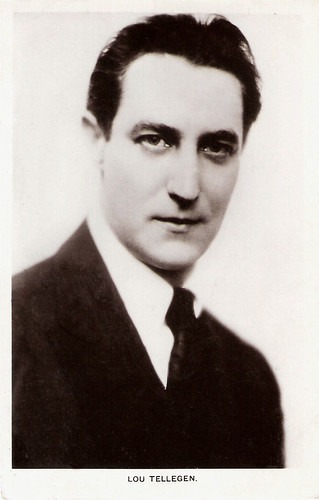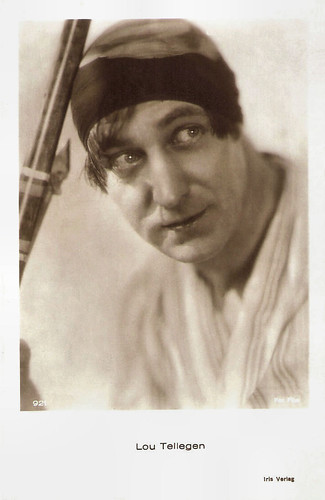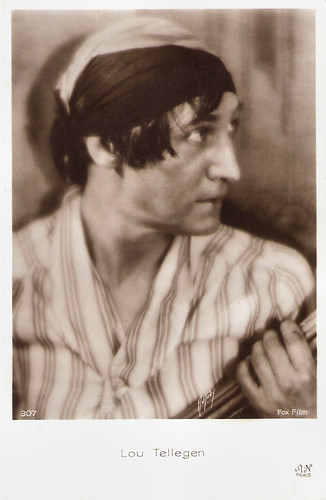
British postcard in the Picturegoer series, London, no. 212.
The Divine Sarah
Lou Tellegen (or Lou-Tellegen) was born as Isidor Louis Bernard Edmon van Dommelen in Sint-Oedenrode, The Netherlands, in 1883 (several sources mistakenly mention 1881). He was the illegitimate child of former army lieutenant Isidor Louis Bernard Edmon Tellegen and actress Anna Maria van Dommelen. His family moved a year later to Nijmegen and then to Amsterdam.
Lou made his stage debut in 1903 with the stage company Rotterdamsch Tooneel of Dieck van Eysden. He moved to Brussels and later to Paris, where he worked as a model for such artists as Lacroix, Constantin Meunier and Auguste Rodin, and as a prize-boxer. He studied at the Conservatoire Nationale de Musique et de Déclamation, and worked for the Théâtre de l'Odéon under André Antoine, the innovative founder of the Théâtre Libre. Tellegen became an eager and dedicated stage actor with Italy’s most famous actress at the time, Eleonora Duse.
Later he met dandy-actor Edouard de Max, who introduced him to Sarah Bernhardt. Eventually Lou co-starred in several roles with the Divine Sarah, and was also romantically involved with her. In 1910, he made his motion picture debut as Armand Duval alongside Bernhardt in La dame aux camellias/Camille (Louis Mercanton, 1911), a French silent film based on the play by Alexandre Dumas, fils.
In 1910, Tellegen and Bernhardt travelled to the United States to appear on stage in Jeanne d’Arc (Joan of Arc). The New York Times first published, and then retracted, the announcement of their impending marriage. She was 37 years his senior.
Back in France, they made their second film together, Les Amours de la reine Élisabeth/Queen Elizabeth (Henri Desfontaines, Louis Mercanton, 1912). The film was an adaptation of a play by Émile Moreau about episodes of the life of Elizabeth I, Queen of England (1533-1603), and focussed on her ill-fated love affair with Robert Devereux, Earl of Essex (Tellegen). It was an enormous success in the U.S., where it was distributed by a young Adolph Zukor.
The following year, Bernhardt and Tellegen appeared again together in Adrienne Lecouvreur/An Actress's Romance (Henri Desfontaines, Louis Mercanton, 1913). This film is considered a lost film. In the summer of 1913, Tellegen went to London where he produced, directed and starred in the Oscar Wilde play The Picture of Dorian Gray.
Edouard de Max. French postcard.
Sarah Bernhardt. Postcard sent from Leipzig, 31 October 1905, to Laibach, Krain, Austria (now Ljubljana, Slovenia). The author wrote in German but using the Greek alphabet and signed Hugo Reizenbach. The adressee was Christl Kantz.
One of the Best-looking Actors on Screen
Invited back to the United States, Lou Tellegen worked in the theatre and soon became a matinee idol. One of the reviews read: 'French romance, hand-kissing romance, dashing romance, it lives again with Tellegen'. His leading role in the melodrama Maria Rosa was a spectacular success.
Samuel Goldwyn, at the time financial director of the Jesse L. Lasky Feature Play Company, saw Tellegen in 1915 in this play and offered him a contract for six films. His American film début was The Explorer (George Melford, 1915), followed by The Unknown (George Melford, 1915), both with Dorothy Davenport as his co-star.
Considered one of the best-looking actors on screen, Tellegen starred in numerous silent films opposite such stars as Sessue Hayakawa, in The Victoria Cross (Edward LeSaint, 1916), and Nell Shipman, in The Black Wolf (Frank Reicher, 1917).
In 1916, he married Geraldine Farrar, a well-known opera diva turned film actress, who was herself known to be the lover of Germany's Crown Prince Wilhelm of Germany. He appeared with Farrar in three films: The World and Its Woman (Frank Lloyd, 1919), Flame of the Desert (Reginald Barker, 1919) and The Woman and the Puppet (Reginald Barker, 1920). Their marriage did not last and they divorced in 1923.
Lou Tellegen had become an American citizen in 1918. He combined his work in the cinema with a successful stage career. Tellegen also worked as a producer and co-wrote two successful plays - Blind youth (1917) with Willard Mack, and The lust of gold (1919) with Andor Garvay – which earned him a lot of money.
For Vitagraph and Fox Film he appeared in numerous silent films including The Redeeming Sin (J. Stuart Blackton, 1925) with Alla Nazimova and Parisian Love (Louis J. Gasnier, 1925) with Clara Bow.
One of his memorable roles was as the corrupt Sheriff in John Ford's Western 3 Bad Men (1926) who wore a white hat instead of the stereotypical bad guy black hat. He directed a film starring Dolores del Rio, No Other Woman (Lou Tellegen, 1928), but it was not a success.

Austrian postcard by Iris Verlag, no. 921. Photo: Fox Film.

French postcard by A.N., Paris, no. 307. Photo: (Max Munn) Autrey / Fox Film.
Harakiri
After his face was damaged in a hotel fire in 1929 and sound film had arrived, Lou Tellegen’s fame faded. According to novelist Kathy Charles, Lou possessed “a high-pitched voice that could curl the hairs on your neck, Tellegen’s career was destroyed by the advent of dialogue in the cinema, and he instantly became a has-been.”
Among his rare sound film appearances were a supporting part in the crime film Enemies of the Law (Lawrence C. Windom, 1931) with Mary Nolan, and a bit part in Caravane (Erik Charell, 1934) starring Charles Boyer. Employment was not forthcoming and debt-ridden, he went bankrupt.
He was diagnosed with cancer, though this information was kept from him, and he became despondent. In 1934, Tellegen locked himself in the bathroom of a mansion of a female admirer, the rich widow Edna Cuhady, on North Vine Street in Los Angeles. He shaved and powdered his face, and while standing in front of a full-length mirror, he committed hara-kiri by stabbing himself seven times with a pair of golden scissors (which had his name engraved on them). Reportedly he was surrounded by newspaper clippings of his career, which he had always cut with the same golden scissors.
According to a 1934 article in Time Magazine, the many obituaries “told how at 15 he ran off with his father's mistress, how he specialized in love-making while he was successively a baker's assistant, a trapeze artist, a model for Auguste Rodin (Eternal Springtime, the original which is now in the Metropolitan Museum), how he first arrived in the U.S. as Sarah Bernhardt's leading man. The final Hollywood picture was of a broken, hollow-eyed matinee idol who kept having his face lifted.“
These obituaries were mostly taken from Tellegen's highly fictitious memoir, Women Have Been Kind (1931). Dorothy Parker called it "rubbish" in Vanity Fair, and suggested the title should have been Women Have Been Kind - of Dumb. Tellegen's wives were Countess Jeanne de Brouckère (1903-1905) - an artist whom he had met while he was an artist’s model in Paris and with whom he had a daughter, Diane; Geraldine Farrar (1916-1923); Isabelle Craven Dilworth - an actress with the stage name Nina Romano (1923-1928) with whom he had a son, Rex; and actress and former Ziegfield girl Eve Casanova (1930-1934).
When asked to comment on Tellegen's death, Geraldine Farrar replied candidly: "Why should that interest me?" The Tellegen interlude, the prima donna claimed long ago, left only "a surface scar." His wife Eve Casanova sent her regrets from New York but did not have the time to attend his funeral. All in all, only 37 family members and friends showed up for the funeral of a man that at one time had millions of fans worldwide.
Lou Tellegen was burned to ashes which, as a last theatrical gesture, he ordered sprinkled on the waves of the Pacific. Posthumously his last film was released, the drama Together We Live (Willard Mack, 1935). In 2011, David W. Menefee published The Rise and Fall of Lou Tellegen.
Short clip from from Les Amours de la reine Élisabeth/Queen Elizabeth (1912). Robert Devereux (Tellegen) is executed. Queen Elizabeth (Sarah Bernhardt) visits his corpse, and mourns for him. Source: swagner99 (YouTube).
Long clip from Parisian Love (Louis Gasnier, 1925) with Lou Tellegen and Clara Bow. Source: classicmoviegirl91 (YouTube).
Sources: Bob Bertina (Lou Tellegen. Een Hollander in Hollywood, VN Bijlage 1985 - Dutch), A.J.C.M. Gabriëls (Institute of Netherlands History), Erik Brouwer (De Volkskrant - Dutch), Kathy Charles (John Belushi is Dead), Allan Ellenberger (Hollywoodland), Time, Wikipedia and IMDb.
7 comments:
What a horribly sad end to his life.
What an interesting post...and yes, a sad end to the first actor's life. I had never heard of that term before. And with a pair of golden sissors! Goodness!
Isn't it interesting that some of the best looking men are not classically handsome, though the women are classically beautiful.
I wonder what their faces looked like when animated! Happy thought--good thing we have YouTube!
Happy PFF!
I truly enjoy the history lesson that goes with each of your posts!
You illuminate the silent era with your posts.
It seems appropriate that Tellegen appeared in the Picture of Dorian Gray after his life. A sad end with a mixture of élan and melodrama.
A very dramatic but sad death.
this is such a sad post...and even sadder is the fact in spite of that final dramatic and amazingly choreographed gesture he didn't become one of the great romantic immortals in death like other stars who have died tragically young.
SO MUCH TO LEARN... thanks for sharing the history of so many with us.
To think Silent Movies are almost 100 years old.
Post a Comment